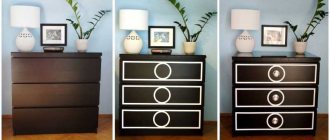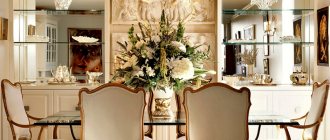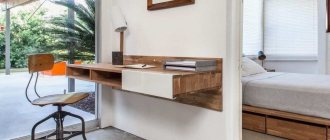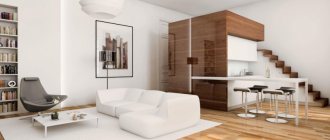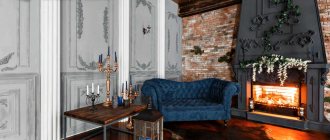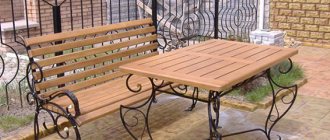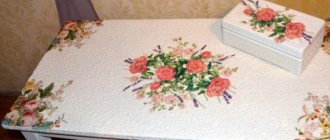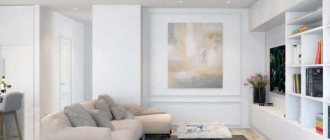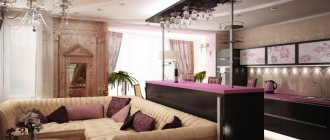Wall shelves are one of the simplest and at the same time common items in the interior. They still do not lose their relevance, it’s just that the shapes have become more complex and intricate, and the colors are bright and unusual.
Wall shelves can be made of various materials; they can be divided into:
- Glass;
- Metal;
- Wooden;
- Shelves made of plasterboard, MDF, chipboard;
- Combined products from 2 or more materials.
According to the type of placement in the interior, shelves are:
- Wall-mounted - they are attached to the wall, most often placed above a large piece of furniture (bed, table, sofa, etc.);
- Suspended - this type is attached to the ceiling using cables, chains, belts and other devices;
- Corner - located between two adjacent walls, they can be attached both to the surface of the walls and to the ceiling.
Depending on the design features, shelves can be cantilever, vertical, horizontal, multi-tiered, inclined, with or without side walls, rounded, and so on.
For each interior, you need to choose special shelves that will not only accommodate your things, but will also become a kind of accent. The photo below shows an example of wall shelves for the Provence style.
Open shelves are used everywhere: in the hallway and kitchen, in the nursery and bedroom, bathroom or living room. They can be mounted on hidden and open brackets, corners, hinges - mounting variations should be combined with the chosen interior style. The most common are brackets: in short, the shelf is tightly seated on a pin and then attached to the wall.
Often, brackets are not only the basis of the structure, but also decorative elements.
Open shelves are actively used to decorate small rooms: they do not overload the room, while the abundance of closed cabinets seems more massive.
Thin shelves on which souvenirs or books are placed are an excellent choice for small rooms, but non-standard shaped shelves are best placed in spacious rooms - where they will look advantageous.
It is also advisable that the intricate shelf be placed on a plain background - this way you will emphasize its beauty and make it one of the fundamental accents.
The material of the shelf is selected in accordance with the style in which the room is decorated: wood is appropriate in the classic style, Provence style, loft, country, shabby chic and others, glass and metal are an excellent choice for hi-tech, modern or fusion style, plasterboard shelves are easy will fit into most styles - the main thing is to focus on the unusual shape.
Shelves in the living room interior
In fact, the living room can be called the “face” of the apartment: guests come here, the whole family gathers here, this room can tell about the tastes, interests and preferences of the owners, so its design must be approached with all responsibility. The interior should be both beautiful and functional. Most often, shelves are placed above the sofa, in niches or near the TV; let's look at each option in more detail.
Shelves painted to match the furniture look good; they do not “eat up” space and visually expand the room. However, techniques for playing with contrasts also work: black or chocolate brown shelves will look good on a light wall (white, beige, cream, light yellow). The chaotically located shelves look interesting (a la a children's labyrinth). Of course, they cannot be called too functional, but their aesthetic qualities are excellent.
If you are looking for a modern option, you can abandon wooden shelves and give preference to glass in different interpretations. Glass can create a special atmosphere of lightness and elegance, so it is suitable even for small rooms. Transparent and matte, colored and patterned, complemented by lighting, shelves fit into most interiors very organically.
Since living room sets and so-called “walls” are gradually losing ground, lighter and simpler solutions are taking their place. Shelving, open shelves, niches, shelves located on corners or around columns are the perfect solution for any living room. It is best to use the space above the sofa or on the opposite wall, but if there is no free space, any corners and partitions will do.
The space around the TV can also be useful: for a high-tech interior, glass shelves arranged in a cascade are suitable, and equipment is already placed in the center. You can frame the TV with hanging shelves (wooden or plastic) and play with contrasts. There are also so-called picture shelves: visually they resemble a canvas frame, inside of which there are small open shelves.
Plasterboard structures are also very convenient, because they can be given any shape and installed with your own hands. Make markings, attach metal or wooden guides, cover with sheets of plasterboard, and then putty and paint the finished shelf. Products that match the color of the wall are very popular - they look like a single whole and do not clutter up the room.
Making a shelf
Let's look at the general instructions on how to make a shelf.
- The very first thing is to clarify the function of the future shelf. Based on this, decide on the material, design, and dimensions. You should also immediately think about where it will be located.
- Next, a sketch of the shelf, drawing, calculation and purchase of materials and fasteners are made. A drawing is a layout plan for all shelf elements indicating dimensions. It is done individually for each shelf. Drawings and dimensions of complex wall shelves are available on the Internet.
- Marking and cutting of the material is done.
- Then comes the assembly of modules.
- Then you should re-measure the dimensions and compare them with the mounting markings.
- The final finishing of the shelf is sanding, tightening, painting or other decoration.
- Installing fasteners on the wall and shelf and actually mounting the shelf on the wall.
In general, making and installing shelves on the wall with your own hands is not difficult. Think about where in the room you can place a new functional decoration and create it yourself.
Wall shelves in the bedroom interior
The first area to pay attention to is the head of the bed. To decorate it, the same techniques are used as for the living room, only the styles differ: minimalism is still more appropriate for the bedroom; not every person likes to sleep with massive shelves hanging over their heads.
You can make asymmetrical or symmetrical corner shelves - they will also look very interesting.
Decorative shelves on the windows would also be appropriate. This solution is suitable for plant lovers: it is best to make the shelves transparent and thin. They are mounted in the window opening: from slope to slope. To make the structure reliable, the window space is strengthened. Small glass shelves will let in enough light, and if you place pots and figurines made of multi-colored glass on them, the effect of stained glass will appear. Shelves can also be made above the window (if the ceiling height allows). You can put light vases, plates, photographs, souvenirs and other things there.
Natural niches and recesses can be turned into spacious shelving, and if you choose an original screen, you can create a spacious dressing room in the corner of the bedroom. The niche doesn’t even need side panels, but lighting won’t be superfluous.
How to arrange decorative elements on shelves and racks?
In addition to the main design elements in the form of furniture, much attention is paid to decorative items. Gradually, the interior is supplemented with various memorabilia: figurines, books, paintings, vases and other little things. In this article we will tell you how to make these memorabilia a harmonious continuation of the interior of your home.
Advice. There can never be too many memorabilia, but it is not necessary to display them all in a prominent place; they should not clutter up the space, but be a pleasant addition to the decor. Therefore, it is recommended to use beautiful containers or wicker baskets to store them. To store the accessories of your home, you can choose containers that match the style and color of the shelves, which will not only organize all the little things, but will also look more neat.
Ideas for decorating shelves and racks
Maintaining balance
The lack of harmony or its presence affects the overall impression of the interior. When there are a lot of decorative items and they are quite varied in terms of size, shape and color, this can easily create an imbalance and the effect of the interior being overloaded with details.
To avoid disturbing the harmony in the appearance of the house, decorative items must be placed on the shelves in such a way that they match or alternate in size, height and shape. For example, you can place an elegant figurine next to a massive book, and carefully stack several books near a narrow and tall vase. It is important to remember that items should be combined and look like a single composition.
Symmetry
The essence of symmetry, as a technique for creating a composition, lies in the principle of placing objects, according to which: on the shelf there should be decorative elements of similar sizes, shapes and matching colors. In this case, the composition will make a pleasant impression and succinctly complete the look of the room.
Items on the shelf should be distributed in such a way that one side is in harmony with the other. For example, if there is a large vase on the upper right side, then the lower left corner should be filled with several small items.
Knowing of limits
The rack should not be overloaded with a large number of things throughout its entire area, this will create the impression of chaos. And beautiful things can get lost among simpler trinkets. It is necessary to leave about 30 percent of the space on the shelf free, and fill the remaining space with decorative items.
Combination with colors
The overall color scheme of your interior determines the shades of colors for decorative items. Things of the primary color should be placed in the foreground, and objects of neutral colors, matched to match, will serve as the background. To avoid imbalance, you should use no more than three colors when selecting the decorative components of the interior. The shades of decorative items should be derived from the colors used in the furnishings of the room. It is also worth paying attention to textiles; for example, the color of curtains can also serve as the basis for the selection of decorative elements.
It is recommended to use a shelving unit in neutral colors (white, black, gray, beige) if the decorative items are varied. At the same time, do not forget about the compatibility of the shelves with the surrounding environment and the decorative item; they should fit laconically into the interior. For example, a shelving unit made of dark wood will fit perfectly where there is furniture made of wood of the same shade and texture, and the decorative elements will be red, red and gold.
Upper shelves
Placing massive bulky things on the top shelves creates a feeling of heaviness that presses from above. It is short-sighted to place bulky objects above the horizon line. Decorative items should be distributed so that all these heavy objects are left on the lower shelves, and from eye level and above it is worth distributing more elegant items, fragile objects in light colors.
Selection of accents
If, after all the efforts to properly organize the decorative elements, the rack looks boring and faceless, then you can complement the composition with accents that can revive and create a more favorable impression of the decor.
Accents involve the use of things that differ from the main composition in color, shape or purpose. They can be placed so that the result is a geometric figure. Such accents can be a bright vase, a textured figurine, books with golden covers; accents can be placed both in the center and along the edges of the shelves at any height.
Wall shelves in the nursery
A children's room should be bright and original; parents try to create the most comfortable atmosphere for their child, carefully selecting every element of the interior. Wall shelves are no exception; you can emphasize the unusual shape - in the form of a tree, a flower or a cloud. They are made from chipboard or plywood, cutting blanks with a jigsaw according to the layout, then putting the structure together and painting it. It wouldn’t hurt to involve your child in this exciting activity.
Wall shelves in the kitchen
Not every apartment has a spacious and large kitchen, so shelves are often assigned a more functional than decorative role. They must be strong and securely fastened; most often they are placed symmetrically - such shelves are more convenient to use, and it is easier to get kitchen utensils and dishes from them. Forged and wooden shelves fit well into the interior of a room of different styles, but glass products are not the best choice. Firstly, they are less practical, and secondly, this is an attribute of modern styles; they fit on everything.
Peculiarities
First of all, shelves are a modern solution. The times of massive wardrobes and sideboards have sunk into oblivion; today designers strive to create the most light and free space, which will have enough space to store necessary (and not so necessary) things.
Shelves help shape the interior space and highlight the necessary zones in it.
These criteria are fully met by a variety of shelves and racks, standard designs or avant-garde designs. Moreover, in the living room, shelves play a more serious role than just placing objects. With their help, the overall design concept and interior style as a whole are formed.
If the shelves are used to store books, you can organize a reading corner next to them. decorating it with a comfortable chair and a small table
Today, it is not difficult for designers to find a suitable shelf for any style and color scheme. And non-standard shelves add an interesting twist to the overall picture and make the interior unique in its own way. In this case, there can be one shelf, or several, located at a certain distance, or in close proximity to each other, of the same color or contrasting shades. All these variations are chosen solely at your request; there are no strict rules in this matter.
When looking for the right shelves, it is important to understand how they will be attached
Wall shelves in the bathroom interior
In the bathroom, hanging or wall shelves are a necessary attribute. Often, glass or plastic is chosen for these rooms - the materials are not afraid of moisture and are also easy to clean from dirt. It is best to place them above the washbasin or on the wall where bath accessories are stored. Fans of non-standard solutions may prefer ceramic shelves - they come in different designs and colors, with their help you can correct defects in the room, emphasize the chosen style, and place accents.
The wood must be laminated and specially treated, since this material is not the most moisture-resistant. Shelves can be made of wood if the bathroom has a wooden door, bathtub or interior items to create a harmonious ensemble. The same can be said about forged products: a mirror in a forged frame and ornate shelves will look very organic!
Types of shelves
Classic wall. If the method of fastening is quite traditional, then the appearance of the shelves has undergone many changes. Now an empty wall can be decorated not only with a simple single board, but also with more complex designs, up to round shelves and at an angle.
Angular. This is a great solution for filling an empty corner. Mounted on adjacent walls. The shelf can be selected for an external or internal angle.
Hanging. This is a relatively new original type of wall shelves. They are mounted on a beam or on a mount in the wall or ceiling. They are not reliable, so it is not recommended to place fragile things on them.
Built-in. This type of shelves is thought out during the process of renovating a room. To do this, using plasterboard, niches are created in the wall, which are then used as shelves.
Foldable. This is an economical option, usually made of fabric. They unfold easily, hold a lot, and can be removed at any time. Suitable for children's or bathroom.
Rackable. Design of several shelves interconnected.
A selection of photos of shelves on the wall will show you what each type might look like and which shelf will suit a particular interior.
